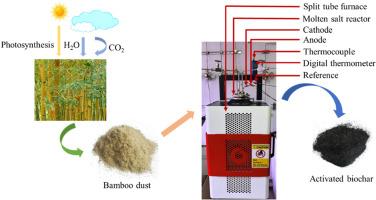Sustainable avenue for biochar production using bamboo dust through a novel thermo-electrochemical process
IF 8.3
2区 工程技术
Q1 CHEMISTRY, PHYSICAL
引用次数: 0
Abstract
Converting waste bamboo dust to biochar reduces greenhouse gas emissions (GHG) and air pollution from open burning, making it an environmentally friendly choice. This study examined the impact of molten salt electrolysis temperatures on the physicochemical parameters of biochar obtained from bamboo dust. Bamboo dust-based biochar is derived at 250 °C, 315 °C, and 380 °C for a reaction time of 3 h. The waste bamboo dust and bamboo biochar derived are evaluated by proximate, ultimate, FESEM, BET, FTIR, and XRD studies. Bamboo dust-derived biochar yields 20.80 % at 250 °C, 19.00 % at 315 °C, and 18.00 % at 380 °C with a constant voltage of 1.5V and current between −0.5 and 0.5 A. The fixed carbon content of bamboo dust-derived biochar ranged between 80.70 % and 86.18 %, which is significantly higher than that of bamboo dust. The carbon content of the biochar ranged from 81.68 % to 87.93 %, with the maximum carbon fraction reported at a molten salt electrolysis temperature of 380 °C. The low elemental ratios of C/H 0.54–0.72 and C/N 0.07–0.15 indicated that bamboo dust biochar is strongly carbonized. Bamboo dust-derived biochar exhibits a BET surface area between 37 and 187.10 m2/g, reaching its maximum at 380 °C. At that temperature, bamboo dust-derived biochar had a total pore volume ranging from 0.05 to 0.11 cc/g. The XRD analysis verified the existence of inorganic compounds like magnesium, manganese and sylvite, calcite, and calcium silicates in bamboo dust-derived biochar, which contribute to their heterogeneous composition and elevated ash content. This study explores the thermo-electrochemical process to produce high-performance activated biochar using alkali-based activation at lower temperatures and applied current. The technique improves porosity, surface area and carbon content, making it a more advanced and sustainable option compared to the traditional process.

一种新型热电化学工艺,利用竹屑生产生物炭的可持续途径
将废竹尘转化为生物炭可以减少温室气体排放和露天焚烧造成的空气污染,是一种环保的选择。研究了熔盐电解温度对竹灰生物炭理化参数的影响。在250°C、315°C和380°C的条件下,反应时间为3小时,得到竹屑生物炭。通过近似、最终、FESEM、BET、FTIR和XRD研究对废竹屑和竹屑生物炭进行了评价。竹屑衍生的生物炭在250°C时产率为20.80%,在315°C时产率为19.00%,在380°C时产率为18.00%,恒电压为1.5V,电流为- 0.5和0.5 a。竹尘生物炭的固定碳含量在80.70% ~ 86.18%之间,显著高于竹尘生物炭。所得生物炭碳含量为81.68% ~ 87.93%,熔盐电解温度为380℃时碳含量最高。C/H为0.54 ~ 0.72,C/N为0.07 ~ 0.15,表明竹尘生物炭炭化程度较强。竹屑生物炭的BET表面积在37 ~ 187.10 m2/g之间,在380°C时达到最大值。在该温度下,竹屑生物炭的总孔体积在0.05 ~ 0.11 cc/g之间。XRD分析证实竹尘生物炭中存在镁、锰、钾盐、方解石、硅酸钙等无机化合物,导致竹尘生物炭组成不均匀,灰分含量升高。本研究探索了在较低温度和外加电流下,利用碱基活化制备高性能活性生物炭的热电化学工艺。与传统工艺相比,该技术改善了孔隙度、表面积和碳含量,使其成为一种更先进、更可持续的选择。
本文章由计算机程序翻译,如有差异,请以英文原文为准。
求助全文
约1分钟内获得全文
求助全文
来源期刊

International Journal of Hydrogen Energy
工程技术-环境科学
CiteScore
13.50
自引率
25.00%
发文量
3502
审稿时长
60 days
期刊介绍:
The objective of the International Journal of Hydrogen Energy is to facilitate the exchange of new ideas, technological advancements, and research findings in the field of Hydrogen Energy among scientists and engineers worldwide. This journal showcases original research, both analytical and experimental, covering various aspects of Hydrogen Energy. These include production, storage, transmission, utilization, enabling technologies, environmental impact, economic considerations, and global perspectives on hydrogen and its carriers such as NH3, CH4, alcohols, etc.
The utilization aspect encompasses various methods such as thermochemical (combustion), photochemical, electrochemical (fuel cells), and nuclear conversion of hydrogen, hydrogen isotopes, and hydrogen carriers into thermal, mechanical, and electrical energies. The applications of these energies can be found in transportation (including aerospace), industrial, commercial, and residential sectors.
 求助内容:
求助内容: 应助结果提醒方式:
应助结果提醒方式:


